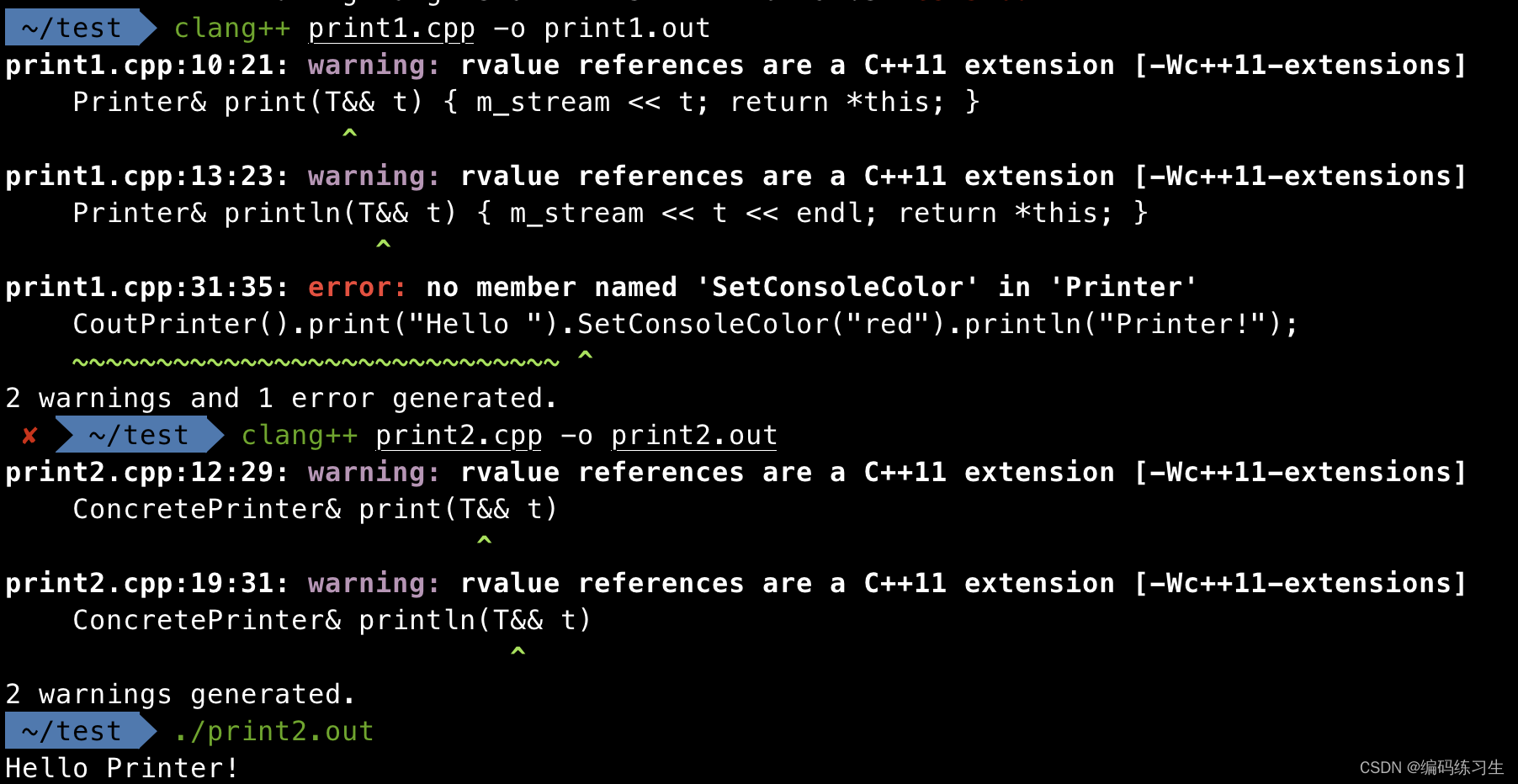目录
3.3多态的复制构造体(Polymorphic copy construction)
一、什么是CRTP
CRTP有两大特性:
- 继承自模板类;
- 派生类将自身作为参数传给模板类。
// 我们先定义一个模板类作为基类
template <typename T>
class Base
{
...
};
// 定义一个派生类,这个类继承以自身作为参数的基类
class Derived : public Base<Derived>
{
...
};二、CRTP的优点
这样做的目的其实很明确,从基类对象的角度来看,派生类对象其实就是本身,这样的话只需要用一个static_cast就可以把基类转化成派生类,从而实现基类对象对派生对象的访问。
template <typename T>
class Base
{
public:
void doSomething()
{
T& derived = static_cast<T&>(*this);
}
};
class Derived : public Base<Derived>
{
public:
void doSomething()
{
std::cout << " Derived class " << std::endl;
}
};这里将基类转换成派生类用的是static_cast静态绑定,而普通基类转派生类用的是dynamic_cast动态绑定。动态绑定的目的是为了确保你所转化的派生类是正确的,而对于CRTP来说,基类是继承于模板类的参数,也就是派生类本身。这也正是CRTP这种设计的目的。
多态是个很好的特性,但是动态绑定比较慢,因为要查虚函数表。而使用 CRTP,完全消除了动态绑定,降低了继承带来的虚函数表查询开销。
三、CRTP的应用
3.1 静态多态
template <class T>
struct Base
{
void interface()
{
// ...
static_cast<T*>(this)->implementation();
// ...
}
static void static_func()
{
// ...
T::static_sub_func();
// ...
}
};
struct Derived : Base<Derived>
{
void implementation();
static void static_sub_func();
};以Base<Derived>::interface() 为例,在Derived : Base<Derived>中,Base<Derived>是先于Derived而存在的,所以当Base<Derived>::interface()被申明时,编译器并不知道Derived的存在的,但由于此时 Base<Derived>::interface() 并不会被实例化。只有当Base<Derived>::interface()被调用时,才会被实例化,而此时编译器也已经知道了 Derived::implementation()的声明了。这里等同于通过查询虚函数动态绑定以达到多态的效果,但省略了动态绑定虚函数查询的时间。
3.2 多态链(Polymorphic chaining)
// print1.cpp
#include <iostream>
using namespace std;
class Printer
{
public:
Printer(ostream& pstream) : m_stream(pstream) {}
template <typename T>
Printer& print(T&& t) { m_stream << t; return *this; }
template <typename T>
Printer& println(T&& t) { m_stream << t << endl; return *this; }
private:
ostream& m_stream;
};
class CoutPrinter : public Printer
{
public:
CoutPrinter() : Printer(cout) {}
CoutPrinter& SetConsoleColor(string s)
{
// ...
return *this;
}
};
int main()
{
CoutPrinter().print("Hello ").SetConsoleColor("red").println("Printer!");
return 0;
}上面Printer定义打印的方法,CoutPrinter是Printer的子类,并且添加了一个设置打印颜色的方法。前半段CoutPrinter().print("Hello ")调用的是Printer实例,后面接着SetConsoleColor(Color.red)实际上又需要调用CoutPrinter实例,这样编译器就会报错。
而CRTP就可以很好的解决这个问题,代码如下:
// print2.cpp
#include <iostream>
using namespace std;
// Base class
template <typename ConcretePrinter>
class Printer
{
public:
Printer(ostream& pstream) : m_stream(pstream) {}
template <typename T>
ConcretePrinter& print(T&& t)
{
m_stream << t;
return static_cast<ConcretePrinter&>(*this);
}
template <typename T>
ConcretePrinter& println(T&& t)
{
m_stream << t << endl;
return static_cast<ConcretePrinter&>(*this);
}
private:
ostream& m_stream;
};
// Derived class
class CoutPrinter : public Printer<CoutPrinter>
{
public:
CoutPrinter() : Printer(cout) {}
CoutPrinter& SetConsoleColor(string s)
{
// ...
return *this;
}
};
int main()
{
// usage
CoutPrinter().print("Hello ").SetConsoleColor("red").println("Printer!");
return 0;
}3.3多态的复制构造体(Polymorphic copy construction)
当我们用到多态时,经常会需要通过基类的指针来复制子对象。通常我们可以通过在基类里面构造一个clone()虚函数,然后在每个子类里面定义这个clone()函数。使用CRTP可以让我们避免反复地在子类中去定义clone()函数。
// Base class has a pure virtual function for cloning
class AbstractShape {
public:
virtual ~AbstractShape () = default;
virtual std::unique_ptr<AbstractShape> clone() const = 0;
};
// This CRTP class implements clone() for Derived
template <typename Derived>
class Shape : public AbstractShape {
public:
std::unique_ptr<AbstractShape> clone() const override {
return std::make_unique<Derived>(static_cast<Derived const&>(*this));
}
protected:
// We make clear Shape class needs to be inherited
Shape() = default;
Shape(const Shape&) = default;
};
// Every derived class inherits from CRTP class instead of abstract class
class Square : public Shape<Square>{};
class Circle : public Shape<Circle>{};不使用CRTP,使用普通写法的话需要分别在派生类里定义clone函数才可以。

























 2557
2557











 被折叠的 条评论
为什么被折叠?
被折叠的 条评论
为什么被折叠?








